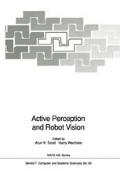Abstract
This paper addresses the problem of forming surface depth estimates from sparse information, which are invariant to three-dimensional rotations and translations of the surface in the chosen coordinate system. We begin this investigation by examining a simplified version of this problem, that of forming invariant curve estimates from sparse data, to help gain insight into the more complex problem in higher dimensions. Two new algorithms are proposed and studied in detail, and several examples are presented to demonstrate their effectiveness. The extension of these algorithms to surfaces in threedimensional space is also briefly discussed.
Access this chapter
Tax calculation will be finalised at checkout
Purchases are for personal use only
Preview
Unable to display preview. Download preview PDF.
References
Poggio, T., T. V. Torre, and C. Koch: Computational vision and regularization theory. Nature 317, 314–319 (1985)
Tikhonov, A. N. and V. Y. Arsenin: Solutions of Ill-Posed Problems. Washington, D. C.:V. H. Winston & Sons 1977
Guggenheimer, H. W.: Differential Geometry. New York: Dover Publications, Inc. 1977
Besl, P. J. and R. C. Jain: Invariant surface characteristics for 3D object recognition in range data. Computer Vision, Graphics and Image Processing 33, 33–80 (1886).
Bernoulli, D.: The 26th letter to Euler. In: Correspondence Mathematique et Physique (P. H. Fuss, ed.). St. Petersburg: Academia imperiale des sciences 1843
Malcolm, M. A.: On the computation of nonlinear spline functions. SIAM Journal of Numerical Analysis 14, 254–282 (1977)
Blake, A. and A. Zisserman: Visual reconstruction. Cambridge, Massachusetts: MIT Press 1987
Grimson, W. E. L.: From images to surfaces: a computational study of the human early visual system. Cambridge, Massachusetts: MIT Press 1981
Terzopoulos, D.: Multilevel reconstruction of visual surfaces: variational principles and finite-element representations. In: Multiresolution Image Processing and Analysis (A. Rosenfeld, ed.). New York, NY: Springer-Verlag 1984
Terzopoulos, D.: Regularization of inverse visual problems involving discontinuities. IEEE Transactions on Pattem Analysis and Machine Intelligence PAMI-8, 413–424 (1986)
Terzopoulos, D.: The computation of visible-surface representations. IEEE Transactions on Pattern Analysis and Machine Intelligence PAMI-10, 417–438 (1988)
Boult, T. E. and J. R. Kender: Visual surface reconstruction using sparse depth data. Proceedings of the Computer Vision and Pattern Recognition Conference 1986, Miami, FL, pp. 68–76.
Lancaster, P. and K. Salkauskas: Curve and Surface Fitting. London: Academic Press 1986
Reinsch, C. H.: Smoothing by Spline Functions. Numerische Mathematik 10, 177–183 (1967)
Salkauskas, K.: C1 splines for interpolation of rapidly varying data. Rocky Mountain Journal of Mathematics 14, 239–250 (1984)
Blake, A. and A. Zisserman: Invariant surface reconstruction using weak continuity constraints. Proceedings of the Computer Vision and Pattern Recognition Conference 1986, Miami, FL, pp. 62–67.
Terzopoulos, D.: Multilevel computational processes for visual surface reconstruction. Computer Vision, Graphics, and Image Processing 24, 52–96 (1983)
Lipschutz, M. M.: Differential Geometry. New York, NY: McGraw-Hill 1969
Author information
Authors and Affiliations
Editor information
Editors and Affiliations
Rights and permissions
Copyright information
© 1992 Springer-Verlag Berlin Heidelberg
About this paper
Cite this paper
Stevenson, R.L., Delp, E.J. (1992). Investigation into Building an Invariant Surface Model from Sparse Data. In: Sood, A.K., Wechsler, H. (eds) Active Perception and Robot Vision. NATO ASI Series, vol 83. Springer, Berlin, Heidelberg. https://doi.org/10.1007/978-3-642-77225-2_28
Download citation
DOI: https://doi.org/10.1007/978-3-642-77225-2_28
Publisher Name: Springer, Berlin, Heidelberg
Print ISBN: 978-3-642-77227-6
Online ISBN: 978-3-642-77225-2
eBook Packages: Springer Book Archive

